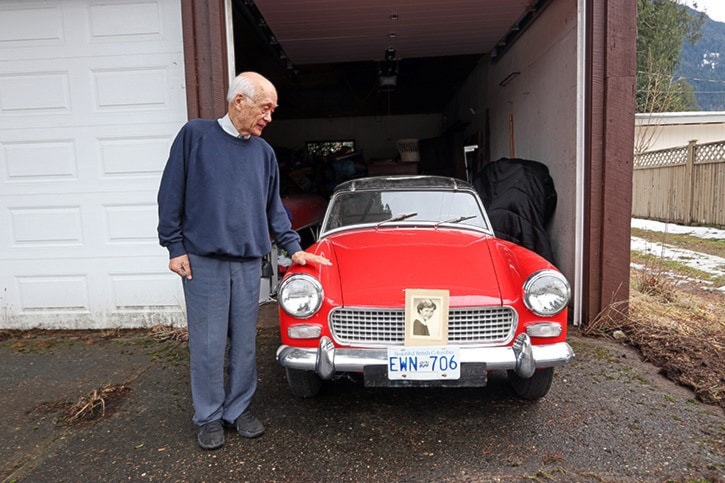If people with handicaps and disabilities needed a hero, they would have found it in Patricia Eileen Murakami in her 55 years living in Hope.
Pat spent her final day here Jan. 27, passing away aged 79 from chronic obstructive respiratory disease and heart failure at the Fraser Hope Lodge, three months after receiving the Governor General's Sovereign's Medal for Volunteers.
“She was very community-minded,” said husband and doctor Ernie Murakami. “For instance — the hospital — I was [the] chairman to build the extended care (Fraser Hope Lodge) ... if there was something to do, she would help.
“She was very happy that she spent her days in a hospital that she helped raised money for.”
Pat's first contribution to Hope came in the formation of an association to help people with mental disabilities and handicaps in 1962.
Pat's many other indelible contributions to Hope include running the hockey school, helping Ernie build the Hope Arena, participating in the Joan Greenwood Foundation and the Tillicum Workshop For The Handicapped.
The hockey school saw former NHL-league players such as defenceman Dennis Kearns, goaltender Charlie Hodge and winger Don Lever at banquets and to teach, whereas the Joan Greenwood Foundation helped people who had financial and domestic violence challenges.
Ernie credits Pat's personality, which gave her satisfaction when helping the handicapped, as the reason for her continued volunteering to help them. Pat studied psychology at the University of British Columbia (UBC), specializing in children. She had a master's that certified her as a clinical diagnostician for children. She also worked for the local school board, then known as the Upper Fraser Valley School Board.
Pat’s sister Lucy Quinn added that while Pat had a relative, Murray Quinn, who needed a wheelchair, she does not believe that had much to do with Pat’s compassion for people with disabilities.
“No, it couldn’t have been because he’s so much younger,” said sister Lucy Quinn. “It was nothing to do with her childhood.
“You can’t always pinpoint why a certain person does certain things.”
Pat’s efforts were first recognized 20 years ago when she received the Governor General’s Caring Canadian Award. On Oct. 14 last year, she received the Sovereign’s Medal for Volunteers, an elevated national honour that replaces the aforementioned award.
Pat was born in Toronto on Sept. 7, 1937 to artists Bert Quinn, of Vancouver, and Ethyl Dee Macdonald of Halifax.
She grew up in Vancouver and went to Queen Mary Elementary School and then to Lord Byng High School before going to UBC.
Pat met Ernie when she was working at the Crease Clinic of Psychological Medicine, doing psychological assessments.
“I was visiting a patient at this hospital, and that's how we met,” said Ernie.
They got married in 1962 and had their honeymoon travelling Europe for a month starting in Nice, France. Ernie also bought a red Austin-Healey Sprite in Vancouver and picked up the convertible at the factory in England.
“That was my wedding gift to her,” said Ernie. “And we toured Europe in it.”
Fifty-five years on, the Sprite has 20,000 miles on the odometer.
“Pat used to use it all the time in the summer,” said Quinn.
Despite being interned during the Second World War, Ernie said by the time they got married, society’s views towards interracial marriages had changed.
“I didn't think it was too bad,” said Ernie.
Pat and Ernie had three children. In 1963, they had their first child, Julie, who now works as a counsellor and a social worker.
“Her mother influenced her because she worked with Pat as a volunteer,” said Ernie.
Their two sons, Paul and Douglas, came in 1967 and 1970. They work in the film and trucking industry respectively.
Pat's health challenges started three years ago when she started losing weight and appetite. Doctors could not pinpoint what happened, naming reasons from smoking to fibromyalgia.
From last July, Pat started going in and out of the hospital.
In Pat's final days, Ernie spent a lot of time by her side. Ten days before her final day in Hope, Ernie sang You Raise Me Up to Pat. Pat stayed awake to listen.
“Ernie went above and beyond,” said Quinn. “I don't think I was the only one in the family more concerned about Ernie's health than Pat's.”
As a doctor, Ernie said he sought every possibility to prolong her life. Doctors respected Ernie enough to follow his recommendations.
Ernie said Pat's decline could have been due to depression, related to Ernie losing his doctor's licence in 2008.
Pat's last words to Ernie were to ask whether the College of Physicians and Surgeons of British Columbia was going to give him an apology.
Ernie said a letter was going to come, although it might not in reality.
“And she looked quite happy with that,” said Ernie.
Pat's celebration of life will be held at Christ Church on Feb. 11 at 1 p.m.
“She lived a full life, there’s no complaining about that,” said Ernie.
“And a good life too,” added Quinn.
